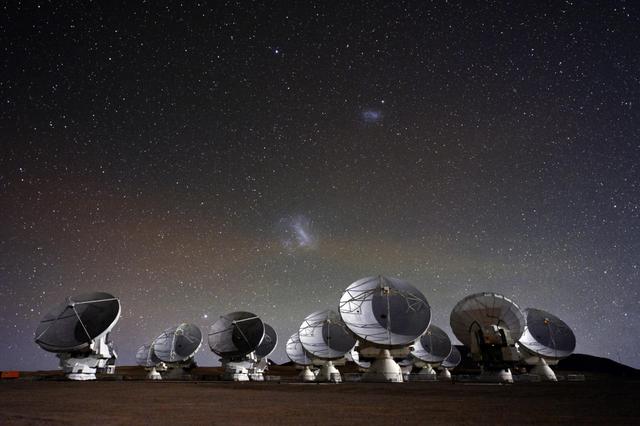ALMA
KICC researchers are leading multiple observing programmes exploiting the Atacama Large Millimeter Array (ALMA), the most sensitive facility in the world at millimeter/submillimeter wavelengths, consisting of 66 high precision antennae, located in the Chile's Atacama desert at an altitude of 5,000 meters. Our observing programmes also leverage the expertise of the Cavendish Astrophysics group, which contributed to the development of some of the key ALMA subsystems. KICC researchers are using ALMA to investigate the gas content, star formation and dynamics of both local and distant galaxies. A sample of current programs is listed below.

ALPINE
The ALMA Large Program to INvestigate CII at Early Times (ALPINE) observed 118 galaxies at z=4.4-5.9, or when the Universe was only 0.9-1.4 billion years old. Each galaxy was observed in a bright tracer of the star formation activity ([CII]158um), as well as the emission from warm dust (FIR continuum). This survey increased the number of such observations by an order of magnitude, and has already resulted in a number of published papers.
Researchers in the KICC have been involved in this project since the proposal phase, and focus on the morpho-kinematic characterization of each source.
High-Redshift Studies
ALMA has enabled observers to detect line emission from galaxies at z>6, who are detected as they were <900 million years after the Big Bang. Through a number of past and present proposals, we are able to determine the rate and history of their star formation, as well as hints of their composition and kinematics. These studies provide key constraints on theories of galaxy evolution and the epoch of reionization
ALMA-KMOS Synergy
Probing the molecular phase of the ISM at the epoch of the peak of mass assembly (1<z<3) is key to shed light on the star formation history of galaxies and on the role played by gas flows in shaping galaxy evolution. Our ALMA program probes the molecular gas content in a sample of thirteen star-forming galaxies at 2<z<2.6, culled from an ESO Large Programme with KMOS (KLEVER), by means of observations of the [CI](1-0) line, a very effective and less biased tracer of the cold molecular ISM compared to the high-J CO transitions. Combining these data with our KMOS observations (which provide robust, spatially resolved information on SFR, metallicity and ionisation conditions of the gas in our galaxies) we can study the scaling relations between stellar mass, metallicity and gas content at z~2 and get crucial insights on the evolution of the gas fraction and the impact of inflows and outflows in driving galaxy evolution along the Main Sequence at these cosmic epochs. Moreover, CO(4-3) will be simultaneously observed in 9 out of 13 galaxies, providing independent estimates of the molecular gas mass which can be exploited to constrain the CO-to-M(H2) conversion factor.
Dusty Starbursts at Cosmic Noon
One of the proposed theories of massive galaxy evolution posits that collisions between galaxies result in significant changes on short timescales. In a gas-rich merger between two galaxies of comparable mass, the star formation rate (SFR) will be boosted by gas mixed and shocks, resulting in a starburst. At the same time, tidal torques will funnel gas into the supermassive black hole at the center of each galaxy, powering the active galactic nucleus (AGN) and resulting in a dust-obscured, reddened quasar. The radiation from the AGN will then expel the gas (lowering the SFR) and dust, resulting in dust-free quasar.
In order to test this model, we have used ALMA to study gas and dust in a sample of z~2.5 (i.e., ~2.6Gyr after the Big Bang) reddened quasars. These sources are found to harbor large reservoirs of molecular gas and significant star formation rates, supporting this theory. Currently, we are examining the kinematics of these systems in order to characterize the relation between the mass of the black hole, gas, and entire system.
Members of KICC involved in ALMA include:


